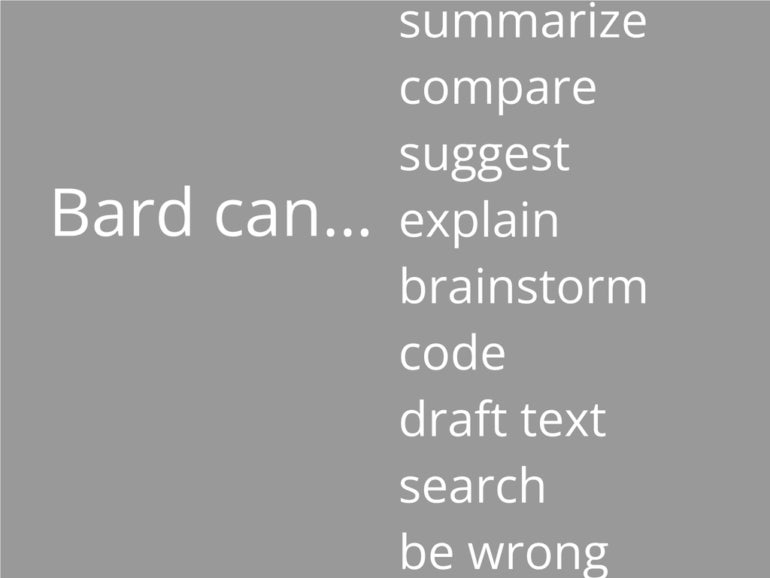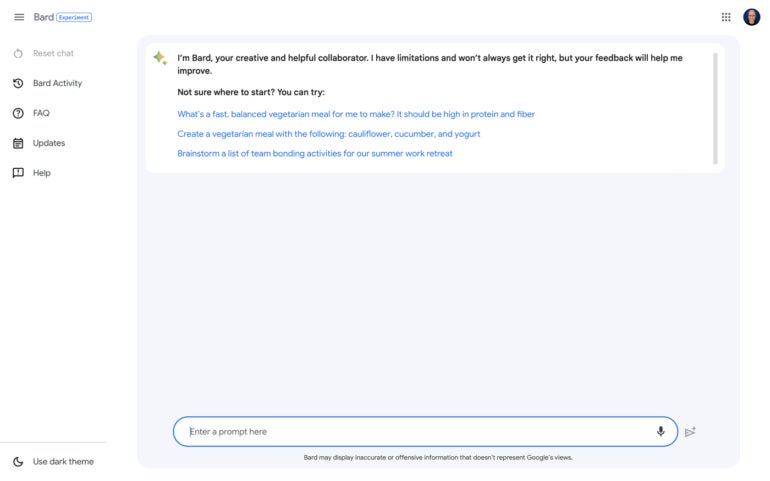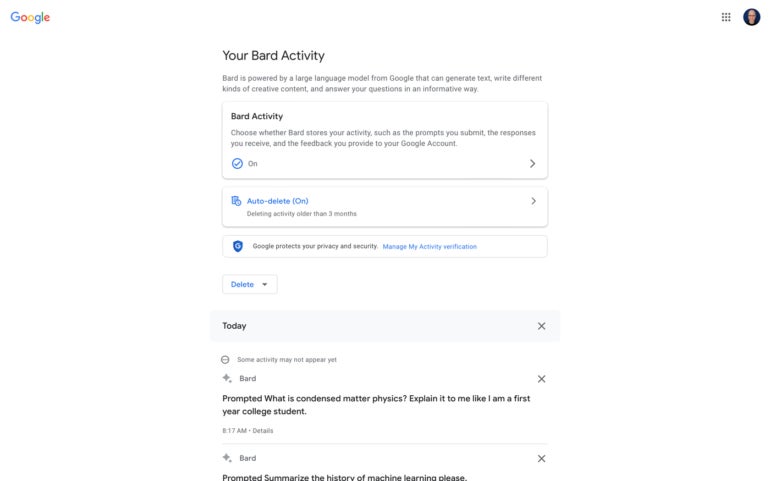
Bard is Google’s artificial intelligence chatbot that generates responses to user-provided natural language prompts. In response to a prompt, Bard can pull information from the internet and present a response. The large language model behind Bard delivers the response in natural language — in contrast to a standard Google search, where a result consists of a snippet of information or a list of links.
SEE: Explore how ChatGPT and other generative AI tools can help you be more productive.
Google announced Bard in February 2023 after OpenAI and Microsoft both garnered attention for AI chatbot systems. And in May 2023, Bard and related AI advancements featured prominently in Google’s I/O event.
According to Sundar Pichai, CEO of Google and Alphabet, Bard is “an experimental conversational AI service.”
In fact, Google places the word “Experiment” next to the system’s name to show it is still a work in progress. Additionally, Google indicates that “Bard may display inaccurate or offensive information that doesn’t represent Google’s views” in a disclaimer placed below the prompt box.
Jump to:
- What is Google Bard used for?
- When was Google Bard released?
- How can you get access to Google Bard?
- What countries and languages is Google Bard available in?
- Can I manage my Google Bard history?
- Is Google Bard free to use?
- Is Google Bard using PaLM 2?
- What are alternatives to Google Bard?
What is Google Bard used for?
Bard’s prompt-response process can help you obtain answers faster than a standard Google search sequence.
A classic Google search requires you to enter keywords, follow links, review content, then compile the results or repeat the process with a refined keyword search string.
SEE: Check out these Google Bard search prompting tips.
With Bard, you enter a prompt, then review the response. If the response isn’t exactly what you want, you have four options:
- View other drafts to display alternatively formatted responses.
- Regenerate the response to have the system craft a new reply.
- Follow-up with another prompt.
- Switch to a search with the Google it button.
Bard can handle all sorts of tasks, but many of the most common uses are covered by the categories of capabilities detailed below.
Google Bard can summarize
As a large language model, Bard can adeptly summarize text. For example, provide a link to a web page and ask Bard to summarize the contents, e.g.:
Please summarize https://blog.google/technology/ai/bard-google-ai-search-updates/.
You also can suggest a specific length if you want a particular degree of brevity, such as “Please summarize in 100 words.”
Google Bard can compare
Bard can compare two or more items. In many cases, when you ask Bard to compare things, the system will display some of the data in a table. For example, if you prompt Bard:
Compare a Pixel 7, Pixel 7a and Samsung Galaxy S23.
Similarly, you may ask Bard to compare web pages.
Google Bard can suggest
Bard may serve as a suggestion engine for products, services or activities. Enter the title of books, music or movies you like, then ask Bard to suggest others. This can be useful when you’re researching unfamiliar topics. For example, you might try:
I am interested in learning the history of machine learning. Can you recommend 10 useful and highly respected books on the topic?
Google Bard can explain
When you want to learn about a topic or historical event, you can ask Bard to explain it to you. If you like, you may suggest a desired level in order to guide the system toward an explanation that may be either easier to understand or more detailed. For a general overview of a core technology that helps make Bard work, you might ask:
Can you explain the basics of how neural networks operate? Explain it to me as if I am in my first year of college.
Google Bard can brainstorm
One of the best uses of a chatbot is to gather a long list of ideas. Ask Bard to “Brainstorm ideas for…” followed by whatever topic you wish, such as a new project, promotional effort or paper. Encourage Bard to provide creative, unusual or inventive ideas for additional variety in the responses.
Google Bard can code and debug
In April 2023, Bard added the ability to create and help debug code in more than 20 programming languages. When you ask for code, make sure to specify the programming language and describe in as much detail as possible the code you need. If the code generated doesn’t work, let Bard know what exactly went awry, and ask for a suggested fix or for help interpreting an error code.
SEE: Explore other Google Bard enhancements.
Bard can draft text
Bard can help you write, too. As with most prompts, provide as much detail about the topic, length, format (blog post, poem, essay, book report, etc.) and style as possible. If you have a rough outline of a blog post, you might include the desired points in your prompt. For this section of text, for example, you might prompt:
Using the following points as an outline, can you draft examples and explanatory text? "Bard can summarize. Bard can compare. Bard can suggest. Bard can explain. Bard can brainstorm. Bard can draft text. Bard can code (and debug). Bard can search."
The responses Bard generated were reasonable and might have required only a little editing and correction to be usable.
Google makes it easy to move Bard text elsewhere. Select the response export button to move content to either a new Google Doc or Gmail. Alternatively, select the More button (the three vertical dots), then choose Copy to place the response text on the system clipboard for pasting into any app of your choice.
Bard can search
Since Bard can access internet content, many conventional keyword searches will also work in Bard. Ask about current news topics, weather forecasts or pretty much any standard keyword search string. However, Bard will provide responses mostly in conventional text, sometimes supplemented with images, whereas Google search may show content in custom formats (e.g., weather forecasts often display a chart). When you seek a set of links, switch out of Bard back to a standard Google search.
Bard can be wrong
Bard can get things wrong. Never rely solely on content provided in Bard responses without verification. When Bard does provide an inaccurate, misleading or inappropriate response, select the thumbs down icon to convey to the system that it provided a bad response. Remember, Bard is an experiment.
When was Google Bard released?
At launch in March 2023, Google limited Bard access via a waitlist to people with personal Google accounts. In early May 2023, Google eliminated the waitlist and made Bard more widely available.
How can you get access to Google Bard?
To access Bard, go to https://bard.google.com in a web browser, and sign in with a Google account (Figure A).
Figure A

If your account is managed by a Google Workspace administrator, such as an account for work or school, the administrator may adjust settings to either allow or prevent access to Bard. Check with your administrator, should you have any questions.
If you are a Google Workspace administrator and wish to review or adjust the settings that affect Bard availability for people in your organization, access the Admin console | Apps | Additional Google services | Early Access Apps, then modify the Service status and Core Data Access Permissions as desired.
What countries and languages is Google Bard available in?
As of May 10, 2023, Google expanded Bard to support Japanese and Korean in addition to U.S. English. Simultaneously, Google made Bard available in more than 180 countries and territories. However, Bard was not made available on that date to people in European Union countries, such as Germany, France, Italy and Spain. By the end of 2023, Google intends to make Bard available in the 40 most spoken languages.
Can I manage my Bard activity history?
Yes, Google gives you control over your Bard activity history, much as it does your search and browsing history. To adjust the settings, select Bard Activity from the left menu. Then, you may choose whether Bard Activity history is on or off (Figure B).
Figure B

If on, you may choose to Auto-delete activity after three, 18 or 36 months or not at all. Additionally, you may access your Bard activity history, which can be helpful if you wish to review or rerun a previous prompt.
Is Google Bard free to use?
Yes, Google Bard is available to use for free. As of May 2023, Google Bard remains free of advertising, as well.
Is Google Bard using PaLM 2?
In May 2023 Google announced that Bard had switched to using Pathways Language Model 2 rather than Language Model for Dialogue Applications. Google promotes PaLM 2 as a “state-of-the-art language model with improved multilingual, reasoning and coding capabilities.”
SEE: Learn how to successfully use ChatGPT.
Google plans to make PaLM 2 available in four distinct sizes: Gecko, Otto, Bison and Unicorn. The distinct sizes are intended to serve a wide range of computing environments. The smallest, Gecko, is intended to be functional even on a mobile device without an internet connection.
What are alternatives to Google Bard?
The ability to access current internet content is a key differentiator between Google Bard and many other chatbot AI systems. Many large language model chatbot systems were trained on older data and lack access to information about current events. This inability to browse the internet limits the usefulness of many of these systems.
Three alternatives to Bard that can access current internet content and are worth exploring are:
- Perplexity.ai: Available free on the web with account sign in optional.
- Bing: Available free on the web in Microsoft Edge with Microsoft account sign in.
ChatGPT Plus: Available for $20 per month in a web browser or in an iPhone app. In late May 2023, Microsoft announced that the free edition of ChatGPT will gain access to Bing, as well.







